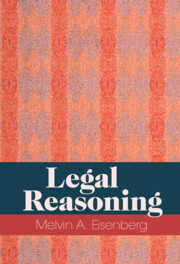Book contents
- Legal Reasoning
- Legal Reasoning
- Copyright page
- Dedication
- Contents
- Preface
- 1 A Brief Introduction to the Common Law
- 2 Rule-Based Legal Reasoning
- 3 Reasoning from Precedent and the Principle of Stare Decisis
- 4 How It Is Determined What Rule a Precedent Establishes
- 5 Reasoning from Authoritative Although Not Legally Binding Rules
- 6 The Role of Moral, Policy, and Empirical Propositions in Legal Reasoning, and the Judicial Adoption of New Legal Rules Based on Social Propositions
- 7 Legal Rules, Principles, and Standards
- 8 The Malleability of Common Law Rules
- 9 Hiving Off New Legal Rules from Established Legal Rules, Creating Exceptions to Established Rules, and Distinguishing
- 10 Analogy-Based Legal Reasoning
- 11 The Roles of Logic, Deduction, and Good Judgment in Legal Reasoning
- 12 Reasoning from Hypotheticals
- 13 Overruling
- Acknowledgments
- Index
4 - How It Is Determined What Rule a Precedent Establishes
Published online by Cambridge University Press: 22 September 2022
- Legal Reasoning
- Legal Reasoning
- Copyright page
- Dedication
- Contents
- Preface
- 1 A Brief Introduction to the Common Law
- 2 Rule-Based Legal Reasoning
- 3 Reasoning from Precedent and the Principle of Stare Decisis
- 4 How It Is Determined What Rule a Precedent Establishes
- 5 Reasoning from Authoritative Although Not Legally Binding Rules
- 6 The Role of Moral, Policy, and Empirical Propositions in Legal Reasoning, and the Judicial Adoption of New Legal Rules Based on Social Propositions
- 7 Legal Rules, Principles, and Standards
- 8 The Malleability of Common Law Rules
- 9 Hiving Off New Legal Rules from Established Legal Rules, Creating Exceptions to Established Rules, and Distinguishing
- 10 Analogy-Based Legal Reasoning
- 11 The Roles of Logic, Deduction, and Good Judgment in Legal Reasoning
- 12 Reasoning from Hypotheticals
- 13 Overruling
- Acknowledgments
- Index
Summary
The common law largely consists of rules established in precedents. The rule established in a precedent is the rule that the precedent court stated governed or decided the case before it. That rule is the holding of the precedent. Most statements in judicial opinions are either factual or legal. Factual statements consist of the facts and history of the case. The central legal statement is the holding. Most other legal statements in an opinion are dicta – singular, dictum. Dictum means something said. The holding of a case is binding on lower courts and the deciding court. Dicta are not binding: they concern rules but are not rules. Typically, dicta signal a court’s possible future actions. For example, a dictum may be a rule that the court suggests would be desirable although it is not presently being adopted; a statement of where it would be desirable for the law to go; or a criticism of an established rule that does not rise to the level of undoing the rule. Although dicta are not binding, they can have legal import. For example, they may be employed by a court to foreshadow future changes in the law.
- Type
- Chapter
- Information
- Legal Reasoning , pp. 25 - 33Publisher: Cambridge University PressPrint publication year: 2022

